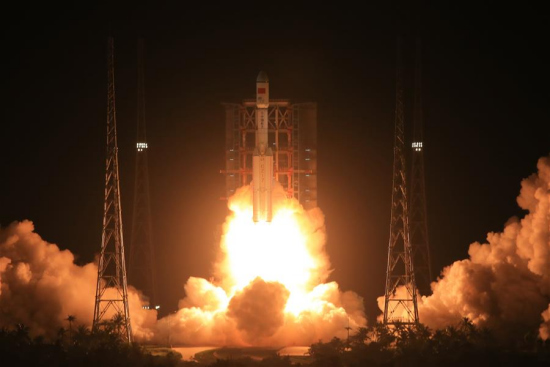
A Long March-7 carrier rocket lifts off from Wenchang Satellite Launch Center, south China's Hainan Province, June 25, 2016. (Xinhua/Li Gang)
China on Saturday successfully blasted off its new generation carrier rocket Long March-7 from a new space launch center in Wenchang, Hainan province.
In a cloud of white smoke, the rocket, carrying a scaled-down version of "a reentry module of a multi-function spacecraft," ascended against a the dark sky, trailing a vast column of flame.
Wang Hongyao, deputy chief commander of the mission, declared the launch a success minutes later.
He said the rocket's payload separated from the rocket 603 seconds after blast-off, and entered an oval orbit with a low point, or perigee, of 200 kilometers, and a high point, or apogee, of 394 kilometers.
The re-entry module is expected to return to Earth on Sunday afternoon.
The Long March-7 is a medium-sized, two-stage rocket that can carry up to 13.5 tonnes to low-Earth orbit. Experts say it will become the main carrier for China's future space missions.
Earlier reports said the rocket now uses kerosene and liquid oxygen as fuel, rather than the highly toxic propellant, making it more environmental friendly and less expensive.
Saturday's launch is the first by the Wenchang site, and the 230th of China's Long March carrier rocket family.
Its mission is to verify the design and performance of the new carrier rocket, to evaluate mission execution capacity of the Wenchang launch site, and to check coordination and compatibility of project-related systems.(Updated)
Read more: A quick guide to China's Long March rocket series
China on Saturday blasted off its new generation Long March-7 carrier rocket for its maiden space flight from the new Wenchang space launch site in south China's Hainan Province.
Measuring 53 meters in length and 597 tonnes in weight, the Long March-7 is a medium-sized rocket that can lift up to 13.5 tonnes to low-Earth orbit.
Earlier reports said it will use new liquid fuel that is less expensive and most importantly environmental friendly.
Long March-7 is widely expected to become the main carrier for China's future space missions.
Its main role will be to transport cargo ships to China's planned space stations, due to enter service around 2022. It could also be used to carry satellites and other spacecraft into orbit.
Saturday's launch mission is the first by the Wenchang site, and the 230th of China's Long March carrier rocket family.
China started development of modern carrier rockets in 1956, and the Long March rockets have become the main carriers for China's satellite launching.
Here is a brief overview of the series.
LONG MARCH-1
The Long March-1 is a three-stage carrier rocket that is used to launch small-sized satellite into LEO (Low Earth Orbit).
With a length of 29.86 meters and maximum diameter of 2.25 meters, the 81.6-tonne Long March-1 has a liftoff thrust of 112 tonnes and is capable of sending a 300-kg satellite into a LEO of 440 km high.
On April 24, 1970, China launched its first satellite, Dong Fang Hong 1, or "the East is Red," into the Earth's orbit on a Long March-1 rocket, becoming the fifth nation to achieve independent launch capacity after the Soviet Union, the United States, France and Japan.
The Long March-1D carrier rocket is a derivation of the Long March-1 and has been put into commercial use with its capacity of sending satellites into LEO.
LONG MARCH-2
The Long March-2 is a two-stage rocket, a base model of many other launch vehicles in the family.
On Nov. 26, 1975, a Long March-2 rocket successfully launched China's first retrievable satellite from the Jiuquan Satellite Launch Center, making China the third country with that capacity.
The Long March-2 was later modified into a number of models, including Long March 2C, 2D, 2E and 2F.
In particular, the Long March-2F was used for China's manned space missions, which has sent 10 Shenzhou spacecrafts and 10 astronauts into space over the years.
LONG MARCH-3
The Long March-3 is a three-stage carrier rocket based on the Long March-2 series. Development of the rocket was completed in 1984.
The third stage of a Long March-3 rocket's flight is powered by liquid hydrogen (LH2) as the fuel and liquid oxygen (LOX) as the oxidizer.
The rocket has a full length of 44.86 meters. Its first and second stages' rockets have a diameter of 3.35 meters while its third stage rocket has a diameter of 2.25 meters.
The Long March-3 has a liftoff mass of 204.88 tonnes and is capable of sending a 1.6-tonne satellite to the geosynchronous transfer orbit (GTO).
The Long March-3 also has a range of derivations such as the Long March-3A, -3B and -3C.
The Long March-3 series was well received by the international market.


















































